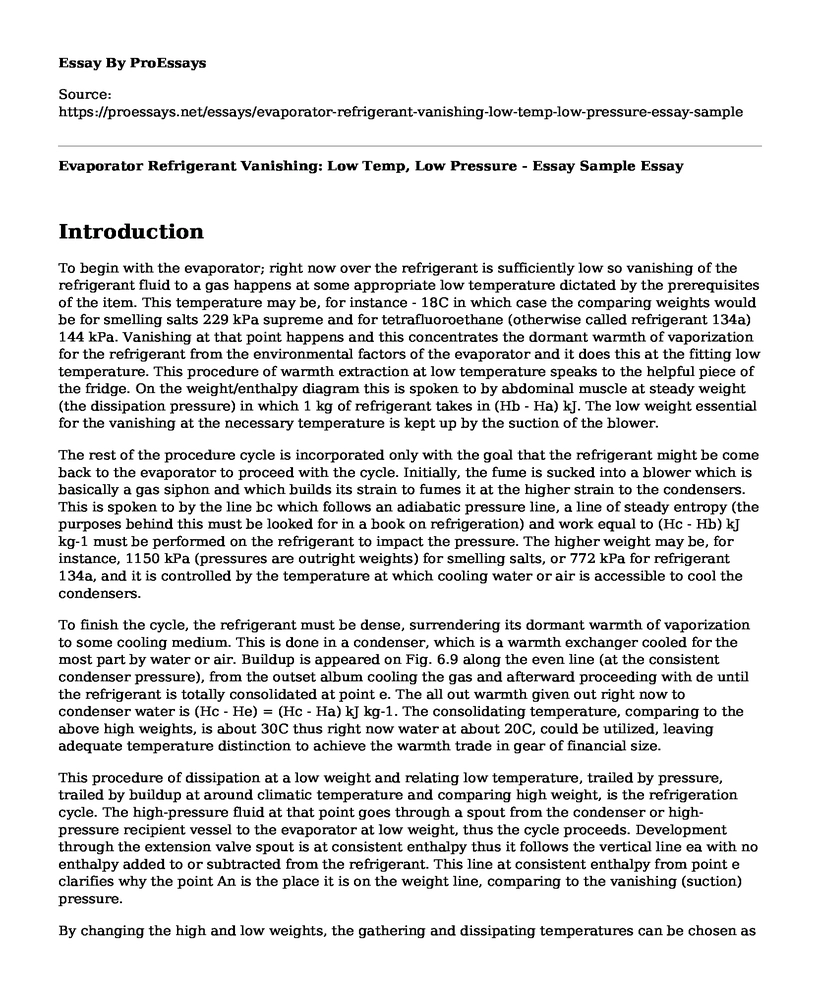Introduction
To begin with the evaporator; right now over the refrigerant is sufficiently low so vanishing of the refrigerant fluid to a gas happens at some appropriate low temperature dictated by the prerequisites of the item. This temperature may be, for instance - 18C in which case the comparing weights would be for smelling salts 229 kPa supreme and for tetrafluoroethane (otherwise called refrigerant 134a) 144 kPa. Vanishing at that point happens and this concentrates the dormant warmth of vaporization for the refrigerant from the environmental factors of the evaporator and it does this at the fitting low temperature. This procedure of warmth extraction at low temperature speaks to the helpful piece of the fridge. On the weight/enthalpy diagram this is spoken to by abdominal muscle at steady weight (the dissipation pressure) in which 1 kg of refrigerant takes in (Hb - Ha) kJ. The low weight essential for the vanishing at the necessary temperature is kept up by the suction of the blower.
The rest of the procedure cycle is incorporated only with the goal that the refrigerant might be come back to the evaporator to proceed with the cycle. Initially, the fume is sucked into a blower which is basically a gas siphon and which builds its strain to fumes it at the higher strain to the condensers. This is spoken to by the line bc which follows an adiabatic pressure line, a line of steady entropy (the purposes behind this must be looked for in a book on refrigeration) and work equal to (Hc - Hb) kJ kg-1 must be performed on the refrigerant to impact the pressure. The higher weight may be, for instance, 1150 kPa (pressures are outright weights) for smelling salts, or 772 kPa for refrigerant 134a, and it is controlled by the temperature at which cooling water or air is accessible to cool the condensers.
To finish the cycle, the refrigerant must be dense, surrendering its dormant warmth of vaporization to some cooling medium. This is done in a condenser, which is a warmth exchanger cooled for the most part by water or air. Buildup is appeared on Fig. 6.9 along the even line (at the consistent condenser pressure), from the outset album cooling the gas and afterward proceeding with de until the refrigerant is totally consolidated at point e. The all out warmth given out right now to condenser water is (Hc - He) = (Hc - Ha) kJ kg-1. The consolidating temperature, comparing to the above high weights, is about 30C thus right now water at about 20C, could be utilized, leaving adequate temperature distinction to achieve the warmth trade in gear of financial size.
This procedure of dissipation at a low weight and relating low temperature, trailed by pressure, trailed by buildup at around climatic temperature and comparing high weight, is the refrigeration cycle. The high-pressure fluid at that point goes through a spout from the condenser or high-pressure recipient vessel to the evaporator at low weight, thus the cycle proceeds. Development through the extension valve spout is at consistent enthalpy thus it follows the vertical line ea with no enthalpy added to or subtracted from the refrigerant. This line at consistent enthalpy from point e clarifies why the point An is the place it is on the weight line, comparing to the vanishing (suction) pressure.
By changing the high and low weights, the gathering and dissipating temperatures can be chosen as required. The high weight is resolved: by the accessible cooling-water temperature, by the expense of this cooling water and by the expense of consolidating gear. The dissipating pressure is controlled by either the low temperature that is required for the item or by the pace of cooling or freezing that must be given. Low dissipating temperatures mean higher force necessities for pressure and more noteworthy volumes of low-constrain fumes to be taken care of in these way bigger blowers, so the pressure is increasingly costly. It should likewise be recalled that, in real activity, temperature contrasts must be given to work both the evaporator and the condenser. There must be lower pressures than those that compare to the vanishing loop temperature in the blower suction line, and higher weights in the blower release than those that relate to the condenser temperature.
By and large, the vitality side of the refrigeration cycle can in this manner be summarized: heat taken in from environmental factors at the (low) evaporator temperature and weight (Hb - Ha), heat equal to the work done by the blower (Hc - Hb) and heat dismissed at the (high) blower weight and temperature (Hc - He).
A helpful measure is the proportion of the warmth taken in at the evaporator (the valuable refrigeration), (Hb - Ha), to the vitality put in by the blower which must be paid for (Hc-Hb). This proportion is known as the coefficient of execution (COP). The unit normally used to gauge refrigerating impact is the ton of refrigeration = 3.52 kW. It emerges from the amount of vitality to freeze 2000 lb of water in one day (2000 lb is called 1 short ton)
Cite this page
Evaporator Refrigerant Vanishing: Low Temp, Low Pressure - Essay Sample. (2023, May 22). Retrieved from https://proessays.net/essays/evaporator-refrigerant-vanishing-low-temp-low-pressure-essay-sample
If you are the original author of this essay and no longer wish to have it published on the ProEssays website, please click below to request its removal:
- Effects of the Mobile Banking in the Financial Sector of the US Banks
- Essay on Screen Time and Content on Toddlers
- Cyber Defense and Artificial Intelligence Paper Example
- "When the Lights Went Out" Review Paper Example
- Essay on Sentinel City: An Accessible Online City With 634,265 Residents
- Essay Example on Diffusion of Innovation: The 5-Stage Process
- Article Analysis Essay on Moped Enabled Mobile Phone Snatches







